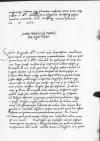Post cf. Ioannes DANTISCUS to Bona Sforza 1543-04-01, CIDTC IDL 6994, letter lost⌊eascf. Ioannes DANTISCUS to Bona Sforza 1543-04-01, CIDTC IDL 6994, letter lost⌋, quas 1543-04-01⌊prima huius1543-04-01⌋ ad Serenissimam Maiestatem Vestram dedi, hoc quod prius de occiso James V Stuart (*1512 – †1542), 1513-1542 King of Scotland; son of King James IV of Scotland James IV and Margaret Tudor⌊Scotland⌊ScotiaeScotland⌋ regeJames V Stuart (*1512 – †1542), 1513-1542 King of Scotland; son of King James IV of Scotland James IV and Margaret Tudor⌋ scripsi, constans fama confirmavit addens insuper, quod principes illi viri Scoti, quos Henry VIII Tudor (*1491 – †1547), 1509-1547 King of England; son of Henry VII Tudor and Elizabeth of York⌊rex England⌊AngliaeEngland⌋Henry VIII Tudor (*1491 – †1547), 1509-1547 King of England; son of Henry VII Tudor and Elizabeth of York⌋ captivos habuit et largiter donatos a se in Scotland⌊ScotiamScotland⌋ dimiserat, ab David Beaton (*ca. 1494 – †1546), 1537 Bishop of Mirepoix, 1538 elevated to Cardinal, 1539 Archbishop of St. Andrews⌊archiepiscopo et primateDavid Beaton (*ca. 1494 – †1546), 1537 Bishop of Mirepoix, 1538 elevated to Cardinal, 1539 Archbishop of St. Andrews⌋ illius regni eiusque partes sequentibus in quodam Scotiae castro obsessi proditoresque ac desertores regis sui declarati atque iterum capti ms. rapti(!)
⌈capticapti ms. rapti(!)
⌉, in England⌊AngliamEngland⌋ sunt remisi. Quae res si sic habet, ut certo fertur, Henry VIII Tudor (*1491 – †1547), 1509-1547 King of England; son of Henry VII Tudor and Elizabeth of York⌊regem England⌊AngliaeEngland⌋Henry VIII Tudor (*1491 – †1547), 1509-1547 King of England; son of Henry VII Tudor and Elizabeth of York⌋ spes sic<c>a destituet. Scribitur etiam, quod Henry VIII Tudor (*1491 – †1547), 1509-1547 King of England; son of Henry VII Tudor and Elizabeth of York⌊rexHenry VIII Tudor (*1491 – †1547), 1509-1547 King of England; son of Henry VII Tudor and Elizabeth of York⌋ ille armatas naves centum in Spain (Hispania)⌊HispaniamSpain (Hispania)⌋ misit, quibus Charles V of Habsburg (*1500 – †1558), ruler of the Burgundian territories (1506-1555), King of Spain as Charles I (1516-1556), King of Naples and Sicily, King of the Romans (1519-1530), Holy Roman Emperor of the German Nation (elected 1519, crowned 1530, abdicated 1556); son of Philip I the Handsome and Joanna the Mad of Castile⌊CaesarCharles V of Habsburg (*1500 – †1558), ruler of the Burgundian territories (1506-1555), King of Spain as Charles I (1516-1556), King of Naples and Sicily, King of the Romans (1519-1530), Holy Roman Emperor of the German Nation (elected 1519, crowned 1530, abdicated 1556); son of Philip I the Handsome and Joanna the Mad of Castile⌋ suis navibus ducentis coniunctus ex Spain (Hispania)⌊HispaniaSpain (Hispania)⌋ ad The Belgians ⌊BelgasThe Belgians ⌋ inferioris Germany (Germania, Niemcy)⌊GermaniaeGermany (Germania, Niemcy)⌋ profecturus perhibetur, quodque a rege Angliae The French ⌊GallisThe French ⌋ publicum indictum sit bellum, unde orbis Christianus novas habiturus est turbas.
Inter domum Burgundiae et Geldriensem ms. Geldecensem(!)
⌈GeldriensemGeldriensem ms. Geldecensem(!)
⌉
dissidium componi non potuit, quod hac aestate instante non parvam rerum perturbationem pariet. De Gustav I Vasa (Gustav Ericsson) (*1496 – †1560), 1523-1560 King of Sweden; son of Erik Johansson and Cecilia Månsdotter ⌊Sweden (Suecia)⌊SueciaeSweden (Suecia)⌋ tyrannoGustav I Vasa (Gustav Ericsson) (*1496 – †1560), 1523-1560 King of Sweden; son of Erik Johansson and Cecilia Månsdotter ⌋, quod prius: nempe milites eum conscribere adhuc rumor est non raucus. Citizens of Hamburg ⌊HamburgensesCitizens of Hamburg ⌋, qui numerosas educere possunt naves, quarum non paucas a The Burgundians ⌊BurgundionibusThe Burgundians ⌋ per pacta ac foedera recuperarunt, illis iuncti relictis nobility of Denmark ⌊Danisnobility of Denmark ⌋ in England⌊AngliamEngland⌋ et in portus
 BJ, 6657, f. 396v
solitos navigationem struunt.
BJ, 6657, f. 396v
solitos navigationem struunt.
Haec sunt, quae de novis parens Serenissimae Maiestatis Vestrae iussis cum hoc nuntio scribenda se offerunt. Cum quo mihi inter eundum occursuro, si Serenissima Maiestas Vestra rescribi commiserit (quod summopere peto), ad ea praesertim, quae adhuc affecta manu in scheda exaravi, gratissimam mihi gratiam impartiet Serenissima Maiestas Vestra. Cui me suppliciter commendo atque omnia faustissima in aetate diutissime florente a domino deo intime precor.
 BJ, 6657, f. 396v
solitos navigationem struunt.
BJ, 6657, f. 396v
solitos navigationem struunt.

